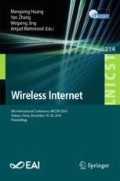Abstract
This paper considers the downlink power allocation in the ultra-dense network. To acquire the maximum sum rate of all the users, we first make the appropriate approximate hypothesis on the interference, and then adopt the Lagrangian Multiplier method and Karush-Kuhn-Tucker condition to obtain the expression of the optimum power allocation. Finally, the iteratively searching water filling algorithm is used to allocate power for each access node, when the total power is limited. Due to the consideration of the computation complexity of the iteratively searching algorithm, we applied the low-complexity water filling algorithm into the power allocation to reduce the iteration times. The simulation results have shown that the performance of the both two water filling algorithms are close, and can improve the sum rate of the users in the ultra-dense network, and the low-complexity water filling algorithm can converge to the optimum solution more quickly.
This work was supported by the China’s 863 Project (No. 2015AA01A709), the National S&T Major Project (2014ZX03004003), Science and Technology Program of Beijing (No. D161100001016002), S&T Cooperation Projects (No. 2015DFT10160B), State Key Laboratory of Wireless Mobile Communications, China Academy of Telecommunications Technology (CATT), and Beijing Samsung Telecom R&D Center.
Access this chapter
Tax calculation will be finalised at checkout
Purchases are for personal use only
References
Bhushan, N., Li, J., Malladi, D., Gilmore, R., Brenner, D., Damnjanovic, A., Sukhavasi, R., Patel, C., Gerihofer, S.: Network densification: the dominant theme for wireless evolution into 5G. IEEE Commun. Mag. 52, 82–89 (2014)
Lopez-Perez, D., Ding, M., Claussen, H., Jafari, A.H.: Towards 1 Gbps/UE in cellular systems: understanding ultra-dense small cell deployments. IEEE Commun. Surv. Tutor. 17, 2078–2101 (2015)
Ren, Q., Fan, J., Luo, X., Xu, Z., Chen, Y.: Analysis of spectral and energy efficiency in ultra-dense network. In: Communication Workshop (ICCW), pp. 2812–2817, London (2015)
Yiqing, Z., Ling, L., Honhyan, D., et al.: An overview on inter-cell interference management in mobile cellular networks: from 2G to 5G. In: International Conference on Communication Systems (ICCS), pp. 217–221 (2015)
Soret, B., Pedersen, K.I., Jorgensen, N.T.K., et al.: Interference coordination for dense wireless networks. IEEE Commun. Mag. 53(1), 102–109 (2015)
Xiaoyi, W., Visotsky, E., Ghosh, A.: Dynamic cell muting for ultra dense indoor small cell deployment scenario. In: IEEE International Conference on Communication Workshop (ICCW), pp. 148–153 (2015)
Yuehong, G., Lei, C., Xin, Z., et al.: Enhanced power allocation scheme in ultra-dense network. China Commun. 12(2), 21–29 (2016)
Yang, S., Yongyu, C., Mengshi, H., et al.: A cluster-based hybrid access strategy using non-cooperative game theory for ultra-dense HetNet. In: IEEE International Conference on High Performance Computing and Communications (HPCC), pp. 14–19 (2015)
Gao, L., Cheng, X., Zhang, Y., Zhu, Y., Zhang, Y.: Enhanced power allocation scheme in ultra-dense small cell network. China Commun. 13, 21–29 (2016)
Jang, J., Lee, K.B., Lee, Y.H.: Transmit power and bit allocations for OFDM systems in a fading channel. In: Global Communications Conference, San Francisco, pp. 283–288 (2003)
Kim, J., Lee, H.W., Chong, S.: Virtual cell beamforming in cooperative networks. IEEE J. Sel. Areas Commun. 32, 1126–1138 (2014)
Shannon, C.E.: A mathematical theory of communication. Bell Syst. Tech. J. 27, 379–423 (1948)
Author information
Authors and Affiliations
Corresponding author
Editor information
Editors and Affiliations
Rights and permissions
Copyright information
© 2018 ICST Institute for Computer Sciences, Social Informatics and Telecommunications Engineering
About this paper
Cite this paper
Su, X., Liu, B., Zeng, J., Wang, J., Xu, X. (2018). A Low-Complexity Power Allocation Method in Ultra-dense Network. In: Huang, M., Zhang, Y., Jing, W., Mehmood, A. (eds) Wireless Internet. WICON 2016. Lecture Notes of the Institute for Computer Sciences, Social Informatics and Telecommunications Engineering, vol 214. Springer, Cham. https://doi.org/10.1007/978-3-319-72998-5_17
Download citation
DOI: https://doi.org/10.1007/978-3-319-72998-5_17
Published:
Publisher Name: Springer, Cham
Print ISBN: 978-3-319-72997-8
Online ISBN: 978-3-319-72998-5
eBook Packages: Computer ScienceComputer Science (R0)

